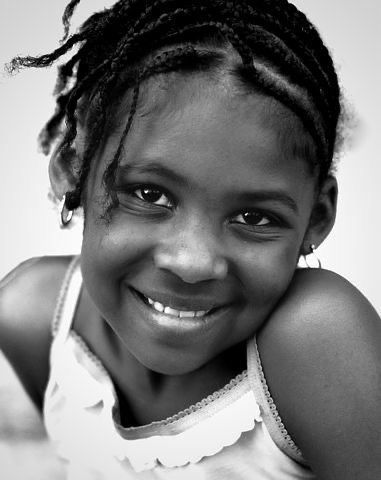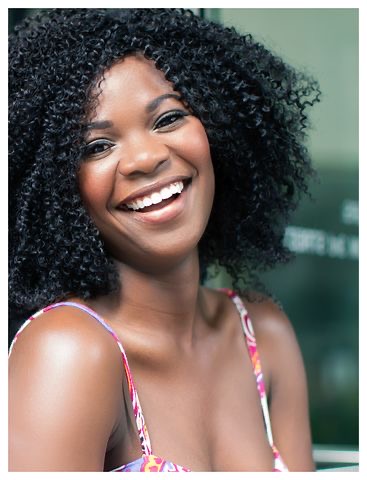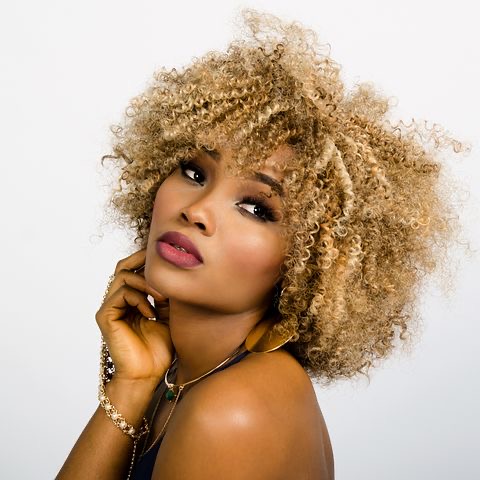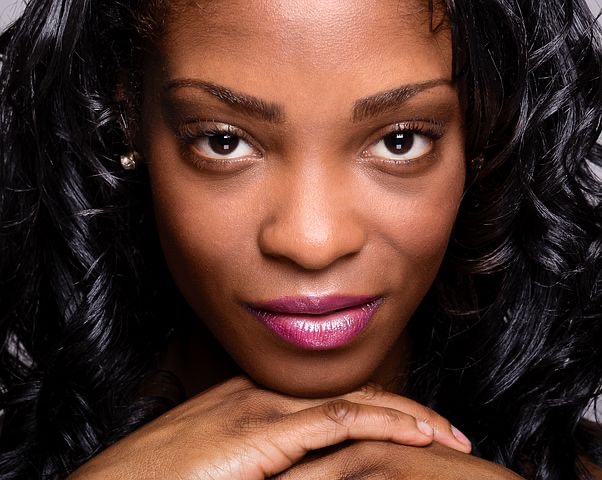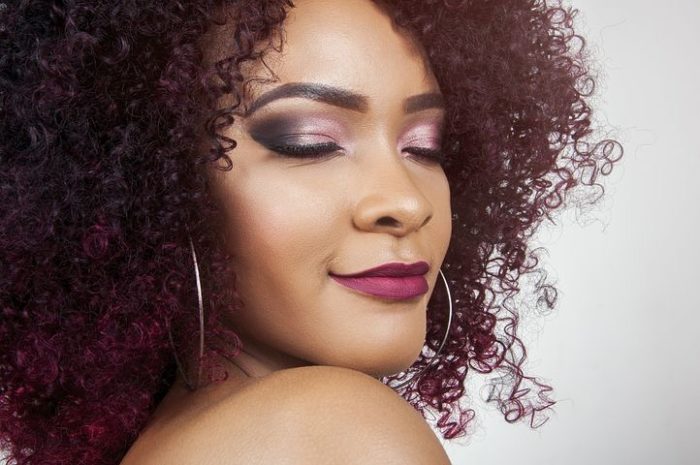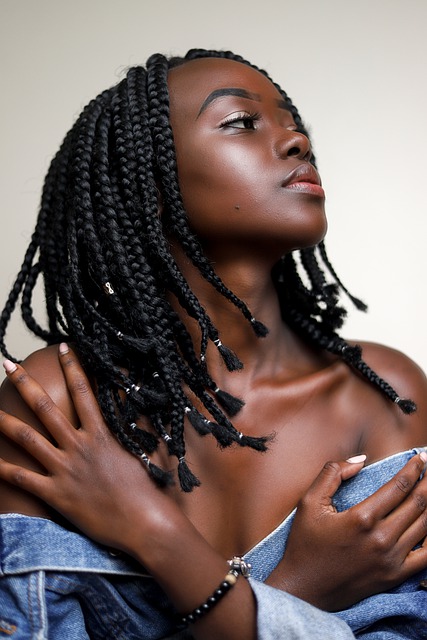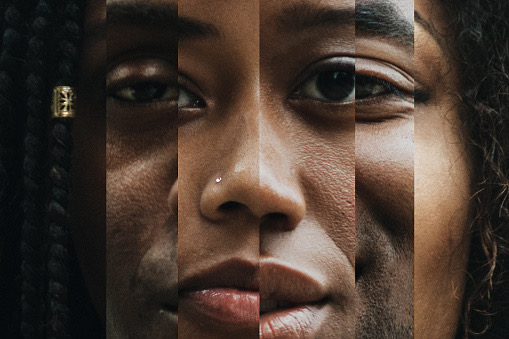
( * ) A montage blend of African American faces close up, both men and women with different shades and colors in skin tone.
By Fatoumata Drammeh
Hair, skin and facial features all play a role in the perceived beauty of an individual under societal beauty standards. Often, black women especially those with darker skin, tighter curls and Afrocentric features are left out of this standard of perceived beauty that is rooted in forms of aesthetic bias we have named “colorism,” “texturism” and ”featurism”.
The first mentions of the word “colorism” appeared in an essay written by activist and author, Alice Walker, in her book, In Search Of Our Mothers’ Gardens. She explains colorism as a “prejudicial or preferential treatment of same-race people based solely on their color.” As we can see preferential treatment and preference is geared towards those with lighter skin tones while those with darker skin tones have been met with exclusion and mistreatment.
At its root, colorism is a product of racism and the idea that white people—along with their white skin—are superior. Thus, the closer you come to looking white, the more preferred you tend to be. We can trace aspects of colorism back to the days of plantation slavery, during which lighter completed slaves were often chosen to work inside their white owners’ homes, while darker skinned slaves were assigned heavier labor in the fields. Mixed-raced children with white fathers were given some privileges as well, like better work or educational opportunities. It was simply another way to divide black folks, and Alice Walker warned in her book that it was an evil that needed to end in order for African Americans to truly move forward.
Unfortunately, instead of stopping this color-based discrimination, the black community itself contributed to it. This idea of lighter skin being better or more advantageous, was deeply instilled within enslaved or colonized black populations, and as a result, even after the end of slavery the effects of this divide persisted within modern black communities as colorist attitudes were perpetuated and accepted.
An example of this was the infamous “brown paper bag test” which African Americans adopted. The test determined whether a black individual was granted entrance to certain buildings, or admission to “African-American social institutions such as sororities, fraternities, and churches.” If one’s skin was lighter than the bag they might enter certain places, occupations, and organizations. However, if one’s skin was darker than the bag they were excluded.
Colorism, texturism and featurism are a few of the reasons why we remember Rosa Parks as the “first” person arrested for refusing to give up her bus seat to a white passenger in Montgomery, Alabama. In reality the first was a black teenager named Claudette Colvin. Due to her dark skin, age, and her later pregnancy, Colvin didn’t have the image leaders of the black community wanted as the face of their emerging protest movement, and so Rosa’s image was pushed instead. According to Claudette: “Parks had the right hair and the right look. Her skin and hair texture was the kind that people associate with the middle class. She fit that profile.” (Npr.org).
Most recently, we can see this kind of bias in everyday media and everyday social interactions. Black men and notably black rappers are often very outspoken about their preference for lighter skinned women, and even praise within their music women with “yellow bones” and “good hair.” On the flip side, when talking about darker skinned women we get comments like Kodak Black’s, “I love black African-Americans, but I don’t like black bitches…. I like yellow hos.” Similarly, GloKKNine, an Orlando rapper, in an interview with Vlad TV said “I’m already black, I don’t need no black bitch,” and when asked if he wanted a child the same complexion as him, replied: “This is a dark-ass shade. This bitch … Hell nah. I can’t …I can’t have.” Sadly, Kodak and GloKKNine’s comments were familiar and not shocking. Many dark-skinned women—although upset—made it clear that they were used to this kind of rhetoric from black rappers, even those with dark skin themselves.
Unsurprisingly, when Hollywood does give a leading role to a dark-skinned actress (like the critically acclaimed Viola Davis), her appearance is still rare enough to generate surprise. Dark skin is constantly put down, not just by rappers but everywhere. In the media we have seen the erasure of dark-skinned women as icons of beauty, especially after the 1990s. What we mostly see now, even in black-centric shows, are the same light-skinned women like Yara and Zendaya, who are of course very talented, but aren’t the only type of female representation the black community has and needs.
Many if not all dark-skinned black girls have and still experience colorism, and can account for these experiences. The issue is just how normalized it is, and how it has destroyed the confidence of so many young black women who sometimes still carry the wounds of this insecurity into adulthood. It also leads to skin bleaching amongst black and African folks. This chemical alteration is even apparent amongst many celebrities who lighten up a few shades after entering Hollywood. A perfect example is singer Dencia and her controversial skin bleaching and skin bleaching products, and her promotional phrase “white means pure.” Rap icon Lil Kim is also another example of drastic skin bleaching, as she made a public “comeback” looking very different than the Lil Kim her many fans knew. However, can we blame them? Dark skin is disparaged constantly. Tik Tok as a public platform for example is filled with colorists and constant attacks against dark-skinned women. One Tik Tok trend had a list in which dark skinned black women were placed at the very bottom, and were priced at $5 dollars below all the other listed races and animals.
Colorism doesn’t only affect the black community. It’s also a cross cultural issue that dark skinned Hispanics and Asians face as well. In the media, at home, and at school, dark-skinned individuals are subjected to ridicule and shame for their color, and it’s simply a problem that is not acknowledged enough.
On Tik Tok, and elsewhere, if a dark skinned woman is considered attractive, she will have a certain set of features that can be described as “Barbie like,” meaning small, thin features. It is already apparent that it’s difficult for dark-skinned women to succeed in image-based mediums from what we see in the rap industry, the modeling industry, and even social media platforms like Tik Tok. The standards for a dark skinned woman to be considered attractive are very, very high compared to how their lighter skinned counterparts are judged. Rarely, do dark-skinned black women ever gain fame just for being “pretty” like wime from other ethnic groups do. They often have to be comedically funny or have some other entertaining quirk that makes them stand out.
Being average isn’t enough. And even if they have that little something “extra” that makes them seem special, they aren’t as appreciated in terms of the amount of followers and attention they get online. Tik Tok is a perfect example of this disparity, and the few darker black women working that platform there who are considered attractive all have the same physical advantage: Although the amazingly talented and beautiful creators @FatracoOn, and @Dasilvadakid don’t exactly have Eurocentric features (because black and African features have always been very diverse) their looks still manage to fit within a Eurocentric standard of beauty.
This Eurocentric standard of beauty and the racist ideology that supports it has come to be called “featurism”— which is when “society is accepting or preferring certain features over others (i.e. certain predominantly European features over African features).” Featurism is often at the root of the common “you’re pretty for a black girl,” and “Are you mixed?” comments aimed at black women who accidentally meet a white standard of beauty.
This is wrong because it implies that black girls are, by definition, “not pretty,” so to be considered “pretty” a black woman must be racially mixed. Meeting white beauty standards usually includes having small noses and light colored eyes; features that can be noticed among the black celebrities Hollywood and society deem beautiful enough.
Not just in America but in many places around the world, there is a beauty standard based upon a European ideal, leaving women with traditional African features behind. Featurism is in part why so many young girls with bigger noses and bigger lips (before it was trendy), hated or felt insecure about their features. Colorism, although different from featurism, intertwines with it to cause confusing double standards depending on passing fads.
We see this double standard with the previously mentioned big lips that were once hated but are now praised. This “acceptance” of big lips as a beauty trend can be attributed to the Kardashian girls and Kylie’s big lip wave. Suddenly big lips were “in” and now everyone was running to doctors to get them. It’s interesting how big lips—which many black women naturally possess and which were once deemed unattractive—became beautiful after white individuals could easily acquire them. Notice how some inherently black features are praised on anyone but black women? This is where colorism and featurism meet.
Featurism, just like colorism, affects other ethnic minorities as well as non-black women of color with characteristic features that challenge the Eurocentric norms. Falling short of supposedly universal ideals of beauty has a negative impact on the self-esteem of all women.
Similar to how women are told they have a “good nose” when it’s petite and slim, black women are told they have “good hair” when it’s loosely curled, or long. For darker-toned black women having “good” hair” becomes even more vital to a positive self image, since colorism is already in play. This idea that good hair is correlated with hair texture has been termed Texturism.
Texturism is “favoring or praising Black hair with looser, finer curl patterns. It’s generally associated with mixed and biracial women but of course, that’s not always the case.” (Fabulize Magazine) Be it through hair ads, songs and in everyday interactions, looser, smoother and longer curls are favored, praised and pushed forward. Unprocessed black hair textures, especially the tighter, very delicate, and densely-packed coils known as type “4C” hair, don’t get as much positive representation and are deemed unattractive.
Black women (particularly the darker ones), can find themselves robbed of their femininity either because feminine traits are forcibly suppressed by a family dynamic, or by having their femininity denied by society due to disrespectful projections of hypermasculinity onto black women. (An example of this last point is how Megan Thee Stallion and Michelle Obama get called Men by their detractors.) As a result, reclaiming and retaining their femininity becomes a priority … and women sometimes attempted to do this through hair styling.
A normal hair shaft can be round or square or something in between. The natural shape of the shaft determines how much your head of hair may curl. Tighter coils make hair appear shorter but this doesn’t mean tight coils aren’t long. Tight curls are longer when stretched out, so 4C hair can actually be long even though many don’t realize this. That’s why 4C hair is stereotypically perceived as “manly” and unattractive. Even when 4C hair is long, people always find a way to put it down, calling it “stiff” or “dry.”
On Tik Tok when girls with 4C hair make videos, there are always negative comments about its natural state. This prejudice against 4C hair makes it really hard for women who have it to embrace it and go natural. Even within the natural hair movement, 4C hair inspired less celebration, while looser hair textures were encouraged. 4C hair can be as beautiful as any other hair texture, so it should receive just as much attention and praise. Yet because of Texturism, many young girls are made to grow up disliking their own hair.
The issue is that whenever people think of a beautiful black woman, the ones that come to mind are almost always lighter, with certain features and loose curls. These features are beautiful, but so are many others. That’s the perspective everyone needs to start working towards establishing. Men are also subjected to these unfair standards, even if they address it less often.
Colorism, texturism and featurism are all oppressive biases that the black community and society as a whole need to acknowledge and address more. Often when people try to discuss these problems, they are shut down or called bitter. That also needs to change.
Of course light skin, loose curls and small noses are beautiful, but so are tighter curls, wider noses and dark skin.
The biggest evil perpetrated by featurism and colorism is making children—and entire ethnic groups—believe they are ugly. Seeing these individuals desperate to lighten their skin, forced to hide their curls, and calling their features ugly online is heartbreaking. The current hierarchical system that categorizes black facial features as less beautiful than others has to be abandoned.
Little by little we are getting there. But It’s high time that everyone equally celebrate all types of hair, skin tones and facial features across every ethnic community, so we can create a more positive and empowering world for all.
* all pictures sourced from Pixabay/Creative Commons
